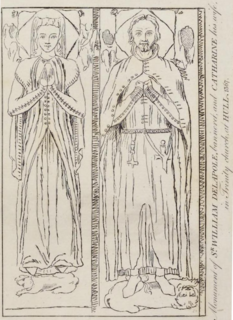 W
WThe Church of the Assumption of the Blessed Virgin Mary, Redenhall is a Grade I listed parish church in the Church of England in Redenhall, Norfolk. It is the mother church of the large ecclesiastical parish of Redenhall-cum-Harleston and Wortwell, with the smaller church of St John the Baptist in Harleston originally being a chapel of ease to Redenhall.
 W
WAlice Chaucer, Duchess of Suffolk, LG was a granddaughter of the English poet Geoffrey Chaucer. Married three times, she eventually became a Lady of the Most Noble Order of the Garter, an honour granted rarely to women and marking the friendship between herself and her third husband William de la Pole, 1st Duke of Suffolk with King Henry VI and his wife Margaret of Anjou.
 W
WJohn de la Pole, 1st Earl of Lincoln was a leading figure in the Yorkist aristocracy during the Wars of the Roses.
 W
WJohn de la Pole, 2nd Duke of Suffolk, KG, was a major magnate in 15th-century England. He was the son of William de la Pole, 1st Duke of Suffolk, and Alice Chaucer, the daughter of Thomas Chaucer. His youth was blighted, in 1450, by the political fall and subsequent murder of his father, who had been a favourite of the king, Henry VI, but was increasingly distrusted by the rest of the nobility. Although the first duke of Suffolk had made himself rich through trade and – particularly – royal grants, this source of income dried up on his death, so John de la Pole was among the poorest of English dukes on his accession to the title in 1463. This was a circumstance which John felt acutely; on more than one occasion, he refused to come to London due to his impoverishment being such that he could not afford the costs of maintaining a retinue.
 W
WMichael de la Pole, 1st Earl of Suffolk, 1st Baron de la Pole, of Wingfield Castle in Suffolk, was an English financier and Lord Chancellor of England. His contemporary Froissart portrays de la Pole as a devious and ineffectual counsellor who dissuaded King Richard II from pursuing a certain victory against French and Scottish forces in Cumberland and fomented undue suspicion of that king's uncle John of Gaunt, 1st Duke of Lancaster.
 W
WRichard de la Pole was a pretender to the English crown. Commonly nicknamed "White Rose", he was the last Yorkist claimant to actively and openly seek the crown of England. He lived in exile after many of his relatives were executed, becoming allied with Louis XII of France in the War of the League of Cambrai. Louis saw him as a more favourable ally and prospect for an English king than Henry VIII.
 W
WSir William de la Pole was a wealthy wool merchant from Kingston upon Hull in Yorkshire, England, who became a royal moneylender and briefly served as Chief Baron of the Exchequer. He founded the de la Pole family, Earls of Lincoln, Earls of Suffolk and Dukes of Suffolk, which by his mercantile and financial prowess he raised from relative obscurity to one of the primary families of the realm in a single generation. At the end of the 14th century he was described in the 'Chronicle of Melsa' as "second to no other merchant of England". He was the founder of the Charterhouse Monastery, Kingston upon Hull.